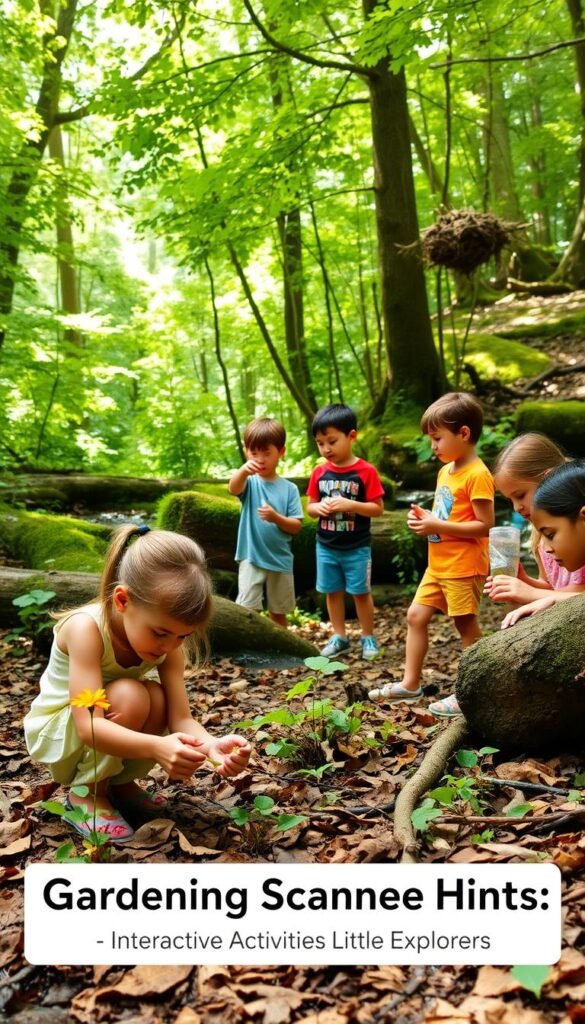Turn your backyard into a thrilling discovery zone where young minds connect with the natural world. Outdoor scavenger hunts blend playful exploration with hands-on learning, creating unforgettable experiences that nurture curiosity. Best part? You only need basic supplies – a list, a bag for treasures, and fresh air.
These adventures require minimal setup but deliver maximum engagement. A simple list of natural items to find – like smooth stones or seasonal leaves – becomes a gateway to understanding ecosystems. Kids develop observation skills while racing to complete their mission, unaware they’re absorbing science concepts through pure excitement.
What makes these hunts special? They adapt to any space – urban balconies with potted plants or sprawling suburban yards. As children compare textures of tree bark or track budding flowers, they’re building confidence through independent discovery. The activity naturally encourages physical movement and creative problem-solving.
Pair your scavenger hunt with simple gardening activities to extend the educational fun. Young explorers might transition from finding earthworms to learning how they help plants grow, making connections that last beyond the game.
Best of all, these nature-based challenges create family memories while fostering environmental stewardship. You’ll watch children’s eyes light up as they shout “I found it!” – proof that learning thrives when wrapped in joy and shared adventure.
Setting the Stage for Your Outdoor Adventure
Transform any green space into a living laboratory where wonder grows naturally. Scavenger hunts activate kids’ natural detective instincts, turning ordinary walks into purposeful missions. The secret? Strategic preparation that balances structure with spontaneity.
Why Nature Treasure Hunts Spark Curiosity
These adventures feed children’s need to investigate their world. When they search for heart-shaped leaves or iridescent beetles, they practice scientific thinking without realizing it. Their eyes learn to spot patterns in bark textures, while fingers compare seed pod shapes.
| Traditional Play | Treasure Hunt | Skills Developed |
|---|---|---|
| Free exploration | Goal-oriented tasks | Focus & determination |
| Casual observation | Detailed inspection | Critical analysis |
| Short attention spans | Sustained engagement | Patience & persistence |
Fueling Excitement for Discovery
Let kids co-create their mission checklist. They’ll beam with pride when crossing off items they suggested. Offer quirky containers for finds – mason jars for “specimen collection” or bandanas for makeshift treasure sacks.
The magic happens when competition meets cooperation. Siblings might race to find acorn caps but team up to decode riddles about mushroom patterns. You’ll hear gasps of triumph as they uncover hidden wonders, building memories that stick like burrs on socks.
The Educational Power of Outdoor Play
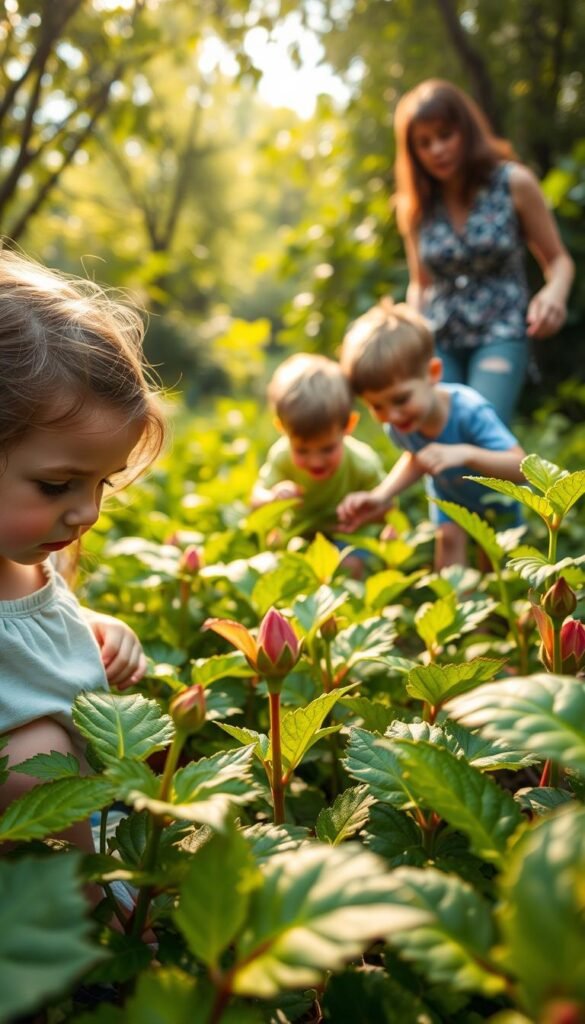
Nature transforms everyday exploration into dynamic lessons that stick. Research from the Journal of Environmental Education reveals outdoor discovery games boost scientific thinking by 40% compared to standard classroom methods. Unlike textbooks, these adventures let children touch, smell, and interact with their lessons.
Boosting Observation and Critical Thinking
Watch how young explorers sharpen their observational skills while hunting for maple seeds or spiderwebs. They’ll compare pinecone sizes and track ant trails – activities that build pattern recognition without flashcards. A study notes:
“Multisensory learning in natural settings creates memory connections three times stronger than screen-based education.”
You’ll notice curious minds asking “Why do worms come up after rain?” or “How do flowers know when to bloom?”. These questions spark critical thinking as kids test theories through hands-on experiments. They’re not just collecting leaves – they’re analyzing why some stay green longer than others.
These activities build transferable skills too. The focus needed to spot bird nests helps children tackle math problems later. When they sketch findings or describe textures, they’re practicing communication – tools that shine in both nature and future science labs.
Exploring the Benefits of Gardening Scavenger Hunts

Unlock hidden growth opportunities where play and education naturally collide. These scavenger hunts turn ordinary green spaces into vibrant classrooms, helping children develop essential skills through hands-on discovery. Unlike screen time, every search for heart-shaped leaves or fuzzy caterpillars becomes a lesson in biology and ecology.
Watch young minds light up during the hunt as they categorize seed pods by texture or match flowers to their scents. This natural classification practice builds pattern recognition that transfers to math and science. When children strategize to find hidden treasures under rocks, they’re honing problem-solving techniques without realizing they’re learning.
| Traditional Learning | Garden Hunt Skills | Real-World Application |
|---|---|---|
| Memorization drills | Active classification | Scientific reasoning |
| Indoor activities | Sensory exploration | Environmental awareness |
| Single-sense focus | Multidimensional experience | Enhanced memory retention |
The thrill of unearthing a pill bug or fragrant herb creates vivid memories that anchor ecological concepts. Families bond over shared missions, turning “I found it!” moments into lasting connections with nature. Through these hunts, children develop respect for living systems while building confidence in their ability to navigate the world.
Gardening Scavenger Hunts: Interactive Activities for Little Explorers
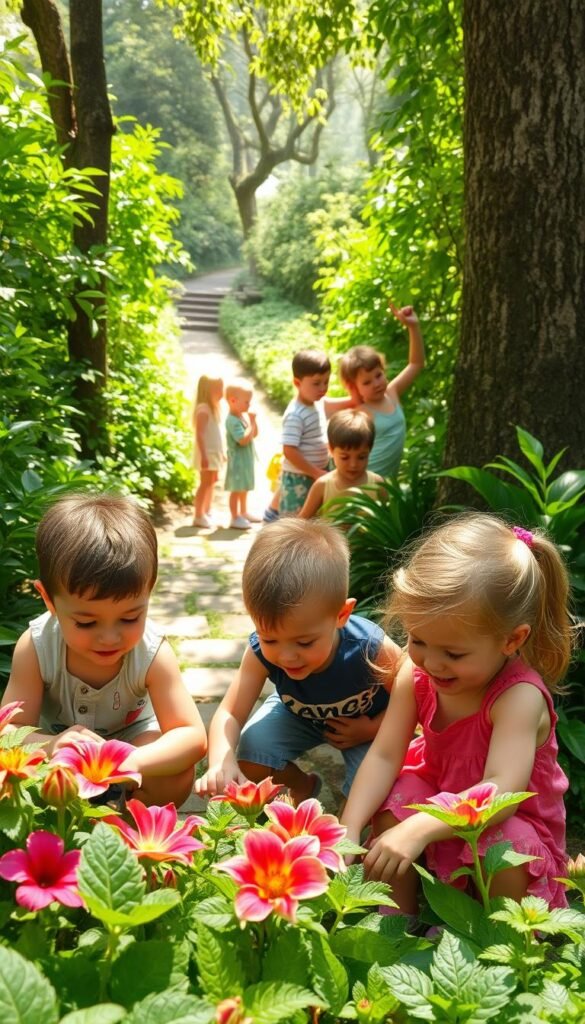
Discover how nature’s playground activates all five senses in vibrant ways. Unlike indoor spaces, gardens burst with textures, scents, and sounds that turn every exploration into a full-body learning experience. This multisensory approach helps children form deeper connections with their environment while building essential cognitive skills.
Engaging Your Child’s Senses
Transform ordinary garden discoveries into extraordinary learning moments. Rough tree bark becomes a texture puzzle, while fragrant mint leaves teach scent recognition. Watch as young explorers gasp when crushing lavender between their fingers – sudden aromas creating instant science lessons.
| Sensory Experience | Indoor Limitations | Outdoor Opportunities | Skills Developed |
|---|---|---|---|
| Touch | Plastic toys | Bark, stones, petals | Tactile discrimination |
| Smell | Artificial scents | Herbs, soil, flowers | Olfactory memory |
| Hearing | Recorded sounds | Birds, insects, wind | Sound identification |
| Sight | Screen colors | Natural hues & patterns | Visual tracking |
Create treasure hunts that challenge kids to find “something crunchy” or “a sweet-smelling leaf”. These activities naturally expand vocabulary as they describe prickly pinecones or buzzing bees. Research shows:
“Multisensory outdoor play increases information retention by 75% compared to single-sense learning.”
End your scavenger hunt with a taste test of edible flowers or herbs. This delicious finale connects sensory exploration to real-world knowledge. Through these experiences, children don’t just learn about nature – they live it through every finger-smudged petal and mud-caked shoe.
Crafting the Perfect Scavenger Hunt List
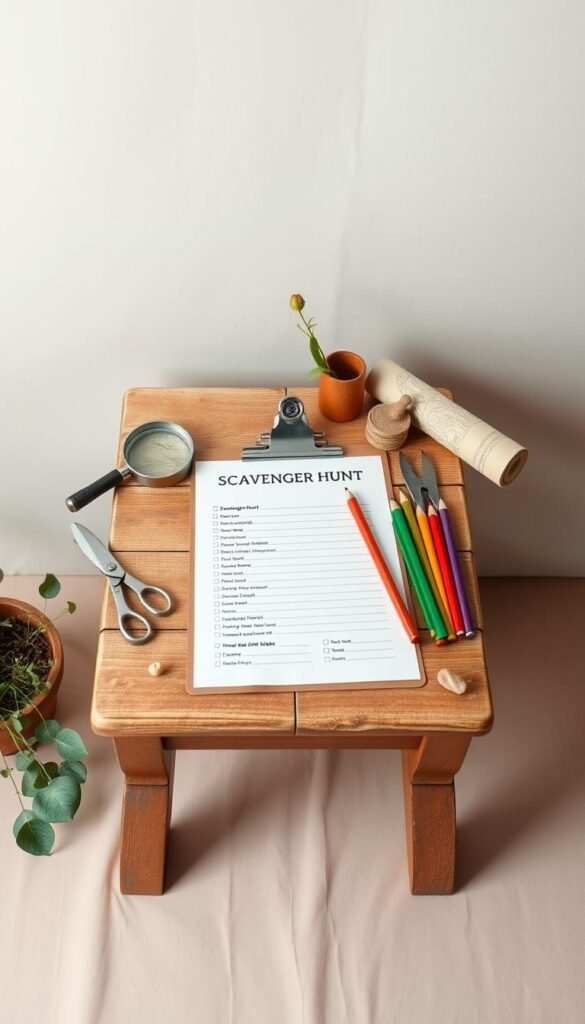
Your mission checklist makes or breaks the adventure. Start with a mix of easy finds and head-scratching challenges to keep energy high. Paper bags for leaf collections and magnifiers for inspecting spiderwebs turn ordinary searches into scientific expeditions.
Key Items and Clues to Include
Balance your list with everyday wonders and seasonal surprises. Include textured bark samples in fall or blooming buds in spring. Clever clues like “Find something that flies without wings” (maple seeds) spark creative thinking. Mix visual cues for pre-readers with rhyming riddles for older kids.
| List Essentials | Skill Boosters | Seasonal Stars |
|---|---|---|
| Colorful petals | Pattern recognition | Spring blossoms |
| Fuzzy caterpillars | Critical analysis | Summer seed pods |
| Smooth stones | Sensory awareness | Fall acorns |
Tips for a Successful Treasure Hunt
Arm explorers with lightweight field guides from your plants and gardening preschool theme lessons. Waterproof notebooks let them sketch discoveries while sunscreen keeps the fun rolling. Pro tip: Laminate checklists for rainy-day replays!
Keep clues age-specific – toddlers thrive with color-based tasks, while 8-year-olds crack coded messages. End with a “mystery item” that changes each hunt, like a heart-shaped rock or feather. Watch confidence bloom as they shout, “I solved it!” through giggles and grass stains.
Seasonal Themes for Dynamic Garden Hunts
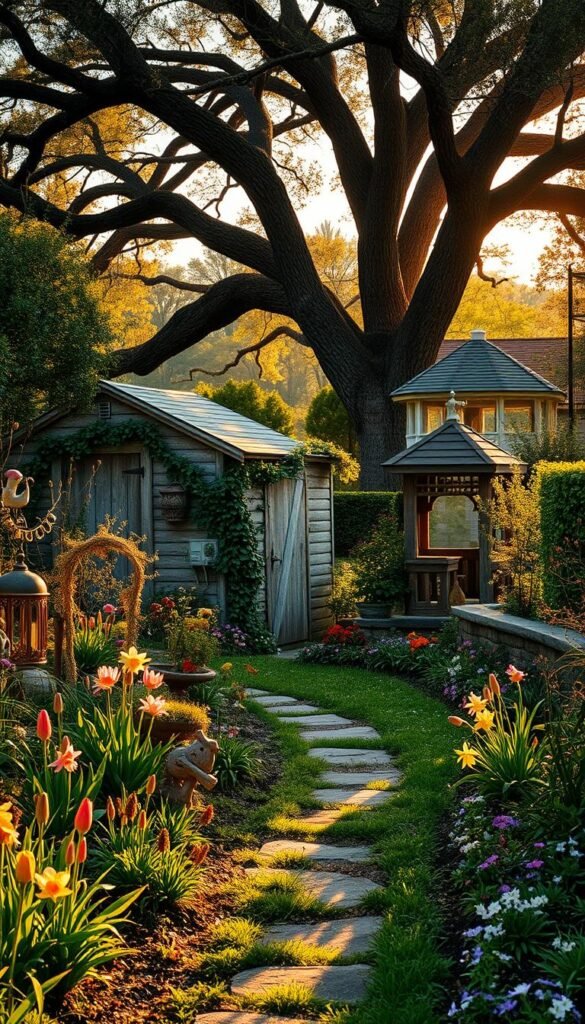
Breathe new life into outdoor explorations by syncing your adventures with nature’s calendar. Seasonal shifts offer fresh opportunities to observe how plants and wildlife adapt, keeping each hunt exciting year-round. This approach helps children see their environment as an ever-changing storybook.
Spring’s Blooming Mysteries
Create checklists bursting with color and growth. Challenge young explorers to spot tulip cups catching morning dew or daffodil trumpets announcing warmer days. Include clues like:
- “Find three types of petals – smooth, ruffled, or spotted”
- “Discover where new leaves uncurl like baby fists”
Turn fallen cherry blossoms into counting games or use magnifiers to study aphids on rosebuds. These activities teach life cycles through hands-on discovery.
Winter’s Frozen Treasures
Transform frosty gardens into wonderlands of hidden patterns. Have kids decode rabbit tracks in fresh powder or compare snowflake shapes on wool mittens. Create texture hunts for:
- Feather-light snow dusting evergreen needles
- Glass-like ice coating berry branches
- Crunchy frozen soil hiding dormant seeds
A study notes:
“Seasonal exploration builds environmental literacy better than static classroom lessons.”
| Spring Focus | Winter Focus | Skills Nurtured |
|---|---|---|
| Bud development | Animal tracking | Pattern recognition |
| Flower diversity | Weather patterns | Hypothesis testing |
| Insect activity | Plant dormancy | Adaptation understanding |
These rotating themes keep the hunt feeling new while teaching respect for nature’s rhythms. Watch as kids compare autumn acorns to spring seedlings – living proof that learning grows best through seasonal adventures.
Observation Skills: Turning Nature into a Classroom
Transform ordinary moments into extraordinary lessons using nature’s endless teaching tools. When kids examine a dandelion’s fuzzy stem or track a ladybug’s path, they’re practicing observation skills that form the foundation of scientific thinking. These real-world experiences stick better than textbook diagrams because they engage multiple senses simultaneously.
Learning Through Sensory Discoveries
Crunchy autumn leaves underfoot and sweet honeysuckle scents become powerful learning tools. As children describe the sticky sap on pinecones or chart butterfly flight patterns, they’re building neural pathways essential for problem-solving. A recent study reveals:
“Students who regularly engage in outdoor discovery show 28% stronger pattern recognition abilities than peers confined to traditional classrooms.”
| Indoor Learning | Outdoor Exploration | Skill Advancement |
|---|---|---|
| Flat images | 3D objects | Spatial reasoning |
| Artificial sounds | Natural acoustics | Auditory discrimination |
| Controlled environment | Changing conditions | Adaptive thinking |
Guide young explorers to document findings through rubbings of tree bark or sketches of flower symmetry. This hands-on approach helps them notice subtle details – like how raindrops bead on waxy leaves versus porous stones. They’ll naturally ask questions about ecosystems, turning casual observation into deep learning.
These experiences do more than teach biology. They help children understand their role in protecting nature while building confidence in their ability to solve real-world puzzles. Every textured leaf becomes a lesson, every birdcall a mystery waiting to be decoded.
Nature Treasures: From Leaves to Insects
Unearth living wonders that turn every outdoor space into a biological showcase. Magnifying glasses become passports to hidden worlds where crawling insects and vibrant leaves reveal nature’s intricate designs. These treasure hunts transform casual exploration into masterclasses in biodiversity.
Spotting Nature’s Signature Features
Equip young explorers with simple tools to decode environmental clues. A magnifier helps spot beetle wing patterns, while field journals capture leaf vein designs. Watch as children learn to distinguish:
| Flora Features | Fauna Clues | Identification Tips |
|---|---|---|
| Serrated edges | Antenna shapes | Compare to guidebook images |
| Opposite leaf arrangement | Wing markings | Note movement patterns |
| Compound flowers | Leg segmentation | Record habitat details |
Autumn adventures might involve creating leaf color gradients, while spring brings mushroom mapping missions. Pair these hunts with vibrant flower projects to expand botanical knowledge. Young naturalists soon recognize how trumpet-shaped blooms attract specific pollinators.
Encourage detailed sketches of beetle shells or spore patterns under logs. As one researcher notes:
“Documenting biodiversity through art boosts species recognition by 62% in elementary students.”
These activities do more than teach identification – they foster respect for ecosystem balance. When children discover aphids farming honeydew, they grasp nature’s interconnected web. Every found treasure, from iridescent wings to feathery seeds, becomes a chapter in their growing environmental storybook.
Crafting Interactive Clues for Young Explorers
Spark wonder in curious minds by designing clues that transform ordinary spaces into discovery zones. The best challenges blend visual prompts with playful language, letting kids decode nature’s secrets through multiple learning styles. Start with simple tools – colored markers, recycled materials, and imagination.
Creating Visual and Written Cues
Use picture clues for pre-readers: a drawing of a maple leaf with three points or a photo of striped rocks. Older adventurers thrive on rhyming riddles like “I’m green and round, but not a bean – find me where the soil’s seen” (pea gravel). Cardboard viewfinders with cutout shapes turn color hunts into art projects – try matching these to printable nature guides for seamless learning.
Combine textures and adjectives for multisensory missions. Ask kids to find “something bumpy like a toad’s back” or “a scent sweeter than rain”. Texture swatches glued to clue cards help tactile learners connect words to real-world objects. Rotate challenge types to keep energy high – one hunt might focus on color gradients, another on insect homes.
Remember: the goal is joyful discovery, not perfection. A smudged sketch of a spiderweb or a misspelled clue sheet still sparks those “aha!” moments. When young explorers proudly present their findings – whether a heart-shaped rock or iridescent beetle – you’ve nurtured both curiosity and confidence.

